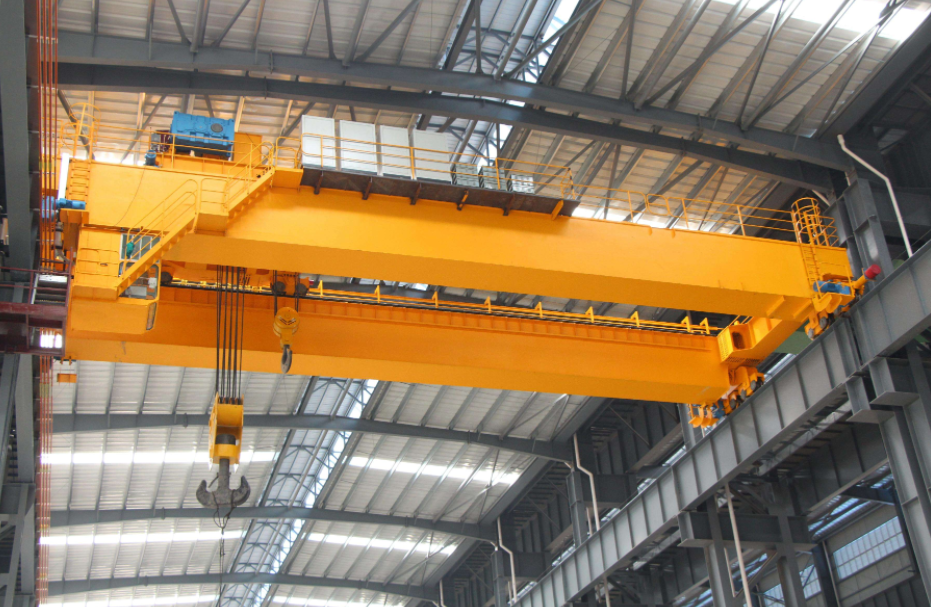The Role of Heavy-Duty Overhead Cranes in the Heavy Manufacturing Industry
- blog@ellsenbridgecrane.com
- Jul 29, 2024
- 4 min read
In the heavy manufacturing industry, where the scale of operations and the weight of materials demand specialized equipment, heavy-duty overhead cranes play an indispensable role. These cranes are essential for handling large and heavy loads efficiently, safely, and with precision. This article explores the importance of heavy-duty overhead cranes in the heavy manufacturing industry, their applications, benefits, and key considerations for their effective use.

The Importance of Heavy-Duty Overhead Cranes
Heavy-duty overhead cranes are designed to lift, move, and position extremely heavy loads with high precision. In the heavy manufacturing sector, where large components and materials are frequently moved, these cranes are vital for several reasons:
Efficiency in Material Handling: Heavy-duty overhead cranes for sale streamline the movement of large and heavy materials, significantly reducing the time required for material handling. This efficiency is crucial in manufacturing processes where time is a critical factor.
Increased Productivity: By enabling quick and precise movement of large components, these cranes boost overall productivity. Manufacturing facilities can operate more smoothly, with less downtime and faster turnaround times.
Safety: Handling heavy materials manually or with inadequate equipment can be hazardous. Heavy-duty overhead cranes enhance workplace safety by minimizing the need for manual lifting and reducing the risk of accidents related to heavy material handling.
Versatility: These cranes can be used in various manufacturing processes, including the assembly of large machinery, fabrication of steel structures, and the handling of raw materials. Their versatility makes them a valuable asset in diverse manufacturing environments.
Applications in Heavy Manufacturing
Heavy-duty overhead cranes find application in several areas within the heavy manufacturing industry:
Steel Production: In steel mills, overhead steel mill cranes are used for handling steel billets, slabs, and coils. They facilitate the transfer of hot steel from one process to another, ensuring efficient production workflows.
Heavy Machinery Assembly: Manufacturing large machinery, such as turbines, generators, and industrial presses, requires precise handling of heavy components. Overhead cranes enable the lifting and positioning of these components during assembly.
Fabrication Shops: In fabrication shops, overhead cranes are employed to move large steel beams, plates, and structural components. They aid in the assembly of complex structures and ensure that materials are correctly positioned for welding and other processes.
Shipbuilding: In shipyards, overhead cranes are used to lift and position large sections of ships, including hulls and superstructures. They play a crucial role in the assembly and launching of vessels.
Automotive Manufacturing: Heavy-duty overhead cranes are utilized in automotive manufacturing for handling large parts and assemblies, such as engine blocks and chassis components. They facilitate efficient production and assembly processes.
Benefits of Heavy-Duty Overhead Cranes
The integration of heavy-duty overhead cranes into manufacturing operations offers numerous benefits:
Enhanced Load Handling: These cranes can handle loads of several tons with ease, making them suitable for industries that deal with exceptionally heavy materials and components.
Improved Precision: Heavy-duty overhead cranes provide precise control over load movements. This precision is essential for tasks that require accurate positioning of components, reducing the likelihood of errors and rework.
Reduced Labor Costs: By automating the process of lifting and moving heavy loads, overhead cranes reduce the need for manual labor. This leads to lower labor costs and allows workers to focus on other critical tasks.
Increased Operational Flexibility: Overhead cranes can be equipped with various attachments and accessories, such as magnets, grabs, and spreader beams, to handle different types of loads. This adaptability enhances the crane's functionality and versatility.
Durability and Reliability: Heavy-duty overhead cranes are built to withstand harsh operating conditions and heavy workloads. Their robust construction ensures long-term reliability and minimizes maintenance requirements.
Key Considerations for Effective Use
To maximize the benefits of heavy-duty overhead cranes, several factors should be considered:
Load Capacity and Specifications: Selecting a crane with the appropriate load capacity and specifications is crucial. Overloading a crane can lead to mechanical failures and safety hazards. It is essential to choose a crane that meets the specific needs of the manufacturing process.
Regular Maintenance: To ensure the reliable operation of heavy-duty overhead cranes, regular maintenance and inspections are necessary. Routine checks can identify potential issues before they escalate, reducing downtime and repair costs.
Operator Training: Proper training for crane operators is essential for safe and efficient crane operation. Operators should be familiar with the crane's controls, safety procedures, and load handling techniques.
Safety Measures: Implementing safety measures, such as load testing, safety audits, and adherence to safety standards, is critical. Ensuring that all safety protocols are followed helps prevent accidents and injuries in the workplace.
Integration with Other Systems: Heavy-duty overhead cranes should be integrated with other manufacturing systems, such as automated production lines and material handling systems. This integration enhances overall operational efficiency and coordination.
Conclusion
Heavy-duty overhead cranes are a cornerstone of the heavy manufacturing industry, providing essential support for handling and moving large and heavy materials with precision and efficiency. Their applications span various sectors, including steel production, machinery assembly, fabrication, shipbuilding, and automotive manufacturing. The benefits of these cranes, including enhanced load handling, improved precision, and increased productivity, make them a valuable asset in manufacturing operations.
To maximize the effectiveness of heavy-duty overhead cranes, it is crucial to consider factors such as load capacity, maintenance, operator training, safety measures, and system integration. By addressing these considerations, manufacturing facilities can leverage the full potential of overhead cranes to optimize their operations and achieve their production goals.








Comments